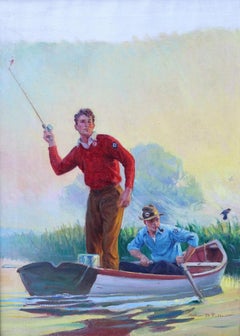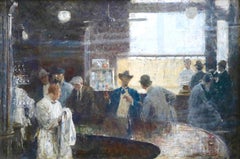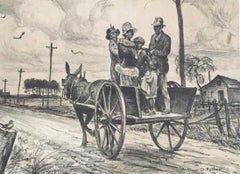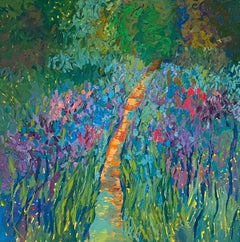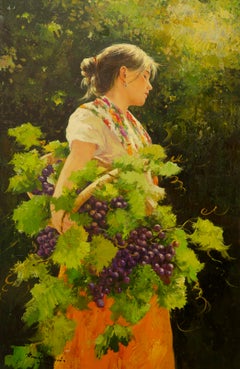Arthur Fuller
to
1
1
1
Overall Width
to
Overall Height
to
3
1
1
2
1
3
3
1
1
1
1
1
1
2
2
2
2
1
3
8,917
2,810
2,504
1,337
2
3
Artist: Arthur Fuller
Fishing, Field and Stream Magazine Cover
By Arthur Fuller
Located in Fort Washington, PA
Date: 1935
Medium: Oil on canvas
Artwork Dimensions: 25.25" x 18.25"
Framed Dimensions: 30.75" x 23.75"
Signature: Signed Lower Right
Cover of June 1935 issue of Field and Stream...
Category
1930s Arthur Fuller
Materials
Oil, Canvas
Bar Scene
By Arthur Fuller
Located in Fort Washington, PA
Signed and dated ‘20 at lower right
Illustrated: Walt Reed, The Illustrator in America 1900-1960’s, p 86
Category
1920s Arthur Fuller
Materials
Canvas, Oil
$36,000
Family on Donkey Cart
By Arthur Fuller
Located in Fort Washington, PA
Signed Lower Right
Category
20th Century Arthur Fuller
Materials
Paper, Charcoal
Related Items
Landscape Painting, Impasto Modern Art, canvas, oil - Pleasure Garden - 35x35 in
Located in Zofingen, AG
ABOUT THE ARTWORK
“Pleasure Garden” is a canvas brimming with the splendor of life and nature, where each flower and leaf pulsates with vitality under the artist’s confident brushstr...
Category
2010s Impressionist Arthur Fuller
Materials
Canvas, Oil
Dasha PogodinaLandscape Painting, Impasto Modern Art, canvas, oil - Pleasure Garden - 35x35 in, 2021
$2,016 Sale Price
28% Off
H 35.44 in W 35.44 in D 0.79 in
Vendimiadora (Grape Harvester)
By Roman Frances
Located in Atlanta, GA
Small limited edition run of 49 and 6 E.A."s (Edition of the artist). Each canvas reproduction is crafted by a skilled printer under the supervision of the artist. Román Francés has...
Category
21st Century and Contemporary Impressionist Arthur Fuller
Materials
Canvas, Oil, Giclée
Marco Ricci follower (Venetian painter)- 18th century landscape painting
Located in Varmo, IT
Venetian painter (18th century) - River landscape with characters.
34 x 26 cm without frame, 43 x 35 cm with frame.
Ancient oil painting on canvas, ...
Category
Early 18th Century Rococo Arthur Fuller
Materials
Oil, Canvas
$1,787 Sale Price
50% Off
H 16.93 in W 13.78 in
Antique painting, fisherman on the coast, oil on canvas.
Located in Berlin, DE
Antique painting, fisherman on the coast, oil on canvas.
Frame damaged in places.
Dimensions with frame.
Category
19th Century Romantic Arthur Fuller
Materials
Canvas, Oil
$1,716 Sale Price
20% Off
H 27.56 in W 31.11 in
"Boulevard a Paris" Post-Impressionist Parisian Street Scene Oil Painting Canvas
Located in New York, NY
A beautiful oil on canvas painting by the French artist, Te Pencke. Pencke was a Parisian painter known for his colorful cityscapes depicting the times of his generation. His work is...
Category
20th Century Post-Impressionist Arthur Fuller
Materials
Canvas, Oil
$4,000
H 27 in W 31 in D 2.5 in
Spanish town street oil on canvas painting Spain urbanscape
By Rafael Fernández de Soto
Located in Barcelona, Barcelona
Rafael de Soto - Village street - Oil on canvas
Oil measurements 41x33 cm.
Without frame.
Category
1940s Modern Arthur Fuller
Materials
Canvas, Oil
$595 Sale Price
50% Off
H 16.15 in W 13 in
Street of the Old Quarter British School signed Cade oil on canvas painting
Located in Barcelona, Barcelona
**Technical Sheet**
**Title:** "Street of the Old Quarter"
**Author:** British School, 19th Century
**Date:** 1892
**Technique:** Oil on canvas
**Dimensions:** 14.17 x 10.63 inc...
Category
1890s American Realist Arthur Fuller
Materials
Canvas, Oil
$834 Sale Price
41% Off
H 14.18 in W 10.63 in
"Boulevard a Paris At Twilight" Impressionist Street Scene Oil Painting Canvas
Located in New York, NY
A beautiful oil on canvas painting by the French artist, Te Pencke. Pencke was a Parisian painter known for his colorful cityscapes depicting the times of his generation. His work is...
Category
Mid-20th Century Post-Impressionist Arthur Fuller
Materials
Canvas, Oil
$4,000
H 28.25 in W 32.25 in D 2.5 in
1760 Flemish Baroque oil painting. Romantic scene. Signed and dated.
By Jan Josef Horemans the Younger
Located in Berlin, DE
Flemish Baroque painting. Romantic scene. Signed and dated.
J. HOREMANS 1760.
This 100% authentic painting captivates with its powerful colors.
A real eye-catcher.
Dimensions witho...
Category
Mid-18th Century Baroque Arthur Fuller
Materials
Canvas, Oil
$38,139 Sale Price
28% Off
H 44.1 in W 35.83 in
Reflection #1, Charcoal Drawing of a Man Gazing Down, Wearing a Bow Tie
By David Becker
Located in Chicago, IL
The dramatic, rich markings left by charcoal appear in the earliest primitive cave painting of early humans, which are believed to have been drawn with the charcoal created from burnt sticks. Of the various kinds of charcoal available today, David Becker often chooses vine charcoal which provides a smooth, softer line. Able to produce lines with either a subtle or strong quality, charcoal is wildly versatile, allowing Becker to approach texture, shading and tone with ease. He is able to capture both gestures and emotions with an intuitive mixture of the soft and the dark.
David Becker
Reflection #1
charcoal on paper
36h x 25w in
91.44h x 63.50w cm
DB0009
David Becker
Exhibitions
2017 Figure8, Gallery Victor Armendariz, Chicago, IL
Coming Attractions, Gallery Victor Armendariz, Cicago, IL
2012 Eye Teeth Group Show, Paint Creek Center for the Arts, Rochester, MI
2011 Art Chicago 2011, Merchandise Mart, Chicago, IL
2010 Art Chicago 2010, Merchandise Mart, Chicago, IL
2009 David Becker Retrospective, Ann Nathan Gallery, Chicago, IL
Art Chicago 2009, Merchandise Mart, Chicago, IL
The 184th Annual Exhibition of Contemporary American Art, National Academy Museum, NYC
Selections, Ann Nathan Gallery, Chicago, IL
2008 Art Chicago 2008, Represented by Ann Nathan Gallery, Merchandise Mart, Chicago, IL
2007 Unruly Muse, Ann Nathan Gallery, Chicago, IL
SOFA NY (Sculptural Objects Functional Art), Ann Nathan Gallery, 7th Regiment Armory, NY, NY
Art Chicago, Merchandise Mart, Ann Nathan Gallery, Chicago, IL
2006 Palm Beach³, Ann Nathan Gallery, Palm Beach, FL
2005 SOFA NY (Sculptural Objects Functional Art), Ann Nathan Gallery, 7th Regiment Armory, NY, NY
Art Chicago in the Park, Butler Field, Ann Nathan Gallery, Chicago, IL
Ann Nathan Gallery, Chicago, IL
Palm Beach³, Ann Nathan Gallery, Palm Beach, FL
2004 Contemporary Prints: National Academy Museum Collection, National Academy of Design, NYC
Art Chicago 2004, Ann Nathan Gallery, Chicago, IL
Fantastic & Visionary Art, touring exhibit: Orange, Manning, Riddoch, & Ballart Gallery, Australia
Return of the Men, Peltz Gallery, Milwaukee, WI
2003 Art Chicago 2003, Ann Nathan Gallery, Chicago, IL
Fantastic & Visionary Art, touring exhibit: Orange Regional Gallery, New South Wales, Australia
National Academy of Design 178th Annual Exhibition, NY, NY
2002 Art Chicago 2002, Ann Nathan Gallery, Chicago, IL
Art of the 20th Century, Ann Nathan Gallery, Park Ave. Armory, NY, NY
Outsider Art Fair, The Puck Building @ Houston & Lafayette Sts., NYC
Self and Other Portraits, Wisconsin Artists, Charles Allis Art Museum, Milwaukee, WI
Return of the Men, Peltz Gallery, Milwaukee, WI
2001 Beyond the 50's, May 4 - July 1, Exhibit A, A Gallery of Art & Design, Birmingham, Michigan
Outsider Art Fair, January 26-28, The Puck Building @ Houston & Lafayette Sts., NYC
"FANTASTIC ART", April/May, Orange Regional Gallery, Orange NSW, Australia.
David Becker: Etchings and Engravings, Ann Nathan Gallery, Chicago, solo exhibition of prints, February.
2000 Four person exhibition, Columbus State University, Columbus, Georgia, Oct. 31 - Nov. 27, 2000.
1999 National Academy 174th Annual Exhibition, NY
University of Wisconsin-Madison Faculty, Elvehjem Museum of Art, Madison, WI
Treasures Revealed: 19th and 20th Century American Works on Paper, National Academy, NY
1995 Bharat Bhavan International Biennial of Prints, Bhopal, India
Contemporary Prints, Selections from John Szoke Gallery, NYC, Drew University, Madison, NJ
Collection Update, 1994, National Academy of Design Museum, NY
1994 David Becker and Robert Sholties, Peconic Gallery, Suffolk Community College, Riverhead, NY
In Black and White: Works by Four Printmakers, Atrium Gallery, University of Connecticut, Storrs
Aesthetics of Athletics: Sports, Games, and Exercise, Charles A. Wustum Musem, Racine, WI
GMI IX Award Winners, Art Center Gallery, Central Missouri State University, Warrensburg
1993 Take Home a Nude benefit auction, NY Academy of Art Graduate School Of Figurative Art, NY
1993 American Prints: Last Half 20th Century, Jane Haslem Gallery, Washingtion, DC
Outstanding American Prints, Anderson Arts Center, Kenosha,WI
National Academy of Design 168th Annual Exhibition, NY
David Becker: Etchings, Davidson Galleries, Seattle, WA
Portraits, Davidson Galleries, Seattle, WA
1992 The Print Fair, 7th Regiment Armory, NY
1991 166th Annual Exhibition, National Academy of Design, NY
Alma College Collection, Detroit Institute of Arts, Detroit, Michigan
Modes of Expression, Potsdam College, SUNY, Potsdam, NY
1990 With Nothing On, Prints and Drawings of the Nude, New Orleans Museum of Art, LA
Prints by Printmakers, Staller Art Center, SUNY-Stonybrook, NY
Publications/Reviews
2007 November 60 Years of North American Prints: 1947-2007, Boston U. Art Gallery, Boston, MA
2003 July 11 Isthmus, Madison, “Welcome to My Nightmare,” by Robert Cozzolino.
2001 March 14 The Wall Street Journal, "Time Off: A Week of Diversions."
Review of Progressive Printmakers (LVM) exhibition.
2001 February Isthmus, Madison, "America's Printland," by Jennifer Smith.
2001 February Capital Times, "The Crowned Prints," by Kevin Lynch.
1999 July Progressive Printmakers: Wisconsin Artists & the Print Renaissance.
1995 – 1999 Who’s Who in America.
1993 Summer The Journal of the Print World, review.
March 14 The New York Times, review.
March 12 The Daily Oklahoman, review.
1990 Dec. 13 The Capital Times, review.
April 28 The Washingtion Post, review.
March 25 The New York Times, review.
Summer The Journal of the Print World, review.
Selected Collections
- additional collections available on requestArkansas Arts Center Foundation, Little Rock, AR
Art Institute of Chicago, Chicago, IL
Brooklyn Museum, NYC
Butler Institute of American Art, Youngstown, OH Detroit Institute of Art, Detroit, MI
Elvehjem Museum of Art, U of Wisconson-Madison
Honolulu Academy of Arts, Honolulu, HI
Library of Congress, Washington, DC
Metropolitan Museum, Miami, FL
Museo de Arte Moderno, Cali, Columbia
National Academy, NY, NY
National Museum of American Art, Washington, DC
New York Public Library, NY
Portland Art Museum, Portland, Oregon
Rose Art Museum, Brandeis University, MA
United States Information Agency, Prague, Czech.
Alberta College of Art, Alberta, Canada
Albion College, Albion, MI
Alma College, Alma, MI
Art Center, South Bend, IN
AT&T Corporate HQ, Plainfield, NJ
Boston Printmakers, Boston, MA
Bradley University, Peoria, IL
Columbia Green Community College, Hudson, NY
Columbus State University, Columbus, GA
Davidson College, Davidson, NC
Dickinson College, Carlisle, PA
Georgia State University – Atlanta
Hope College, Holland, MI
Hunterdon Art Center, Clinton, NJ
Kansas State University, Manhattan, KS
Madison Art Center, Madison, WI
Marui Imai Inc., Sapporo, Japan
Milwaukee Art Center, Milwaukee, WI
Minot Art Association, Minot, ND
North Carolina Print/Drawing Society, Charlotte, NC
North Texas State University – Denton
Ohio University – Athens
Oklahoma Art Center, Oklahoma City, OK
Oklahoma State University, OK
Quad Graphics, Milwaukee, WI
Silvermine Guild of Arts, New Canaan, CT
Springfield College, Springfield, MA
St. Lawrence University, Canton, NY
State University of New York – Fredonia
State University of New York – Potsdam
Trenton State College, Trenton, NJ
University of Arizona Museum of Art, Tucson, AZ
University of Colorado-Boulder
University of Dallas, TX
University of Louisville, Louisville, KN
University of Manitoba, Winnipeg, Canada
University of North Dakota – Grand Forks
University of South Dakota – Vermillion
University of Tennesse – Knoxville
West Chester State College, West Chester, PA
Western Kentucky University – Bowling Green
Private Collections
Carla Leighton, New York, NY
Marc Hauser, Chicago, IL
Michael John Hofer, Chicago, IL
Drs. Mark & Helene Connolly, River Forest, IL
Jamie Kalikow, New York, NY
Dianne & Jim Blanco, Chicago, IL
Denise Roberge, Palm Desert, CA
Tish & Philip Messinger, Creskill, NJ
Brian Wesphal & Michael McVicker, Chicago, IL
Ralph Privoznik, Lafayette, IN
Candice Groot, Evanston, IL
Shomaker/Ruud Collection, Chicago, IL
Braden Berkey and Robert Bartlett, Chicago, IL
Bill and Karyn Silverstein, Highland Park, IL
Steve Weitz, Lovettsville, VA
Mary Allice Wimmer, Madison, WI
Ann & Robert Avery...
Category
21st Century and Contemporary Contemporary Arthur Fuller
Materials
Archival Paper, Charcoal
Sweet dream Still life, Books, French artist, Expressionism Contemporary Collage
By SOPHIE DUMONT
Located in LANGRUNE-SUR-MER, FR
The painting "Sweet Dreams" by Sophie Dumont, measuring 31.5 x 31.5 inches (80 x 80 cm), features an abstract composition reminiscent of a bookshelf or folded fabrics.
The books are...
Category
21st Century and Contemporary Contemporary Arthur Fuller
Materials
Canvas, Oil
$5,470
H 31.5 in W 31.5 in D 0.79 in
Barcelona Spain oil on canvas painting spanish seascape
Located in Barcelona, Barcelona
Pascual Fresquet Almurin (1930) - La Barceloneta Barcelona Spain - Oil on canvas
Oil measures 38x46 cm.
Frame size 48x56 cm.
Painter born in Hospital...
Category
1980s Post-Impressionist Arthur Fuller
Materials
Canvas, Oil
$595 Sale Price
37% Off
H 14.97 in W 18.12 in
Arthur Fuller art for sale on 1stDibs.
Find a wide variety of authentic Arthur Fuller available for sale on 1stDibs. If you’re browsing the collection of art to introduce a pop of color in a neutral corner of your living room or bedroom, you can find work that includes elements of yellow and other colors. You can also browse by medium to find art by Arthur Fuller in oil paint, paint, board and more. Not every interior allows for large Arthur Fuller, so small editions measuring 12 inches across are available. Customers who are interested in this artist might also find the work of Béla Kádár, Wilson Jr. Mortimer, and Liana Vassalou. Arthur Fuller prices can differ depending upon medium, time period and other attributes. On 1stDibs, the price for these items starts at $2,400 and tops out at $36,000, while the average work can sell for $5,200.
Artists Similar to Arthur Fuller
Edward Seago
